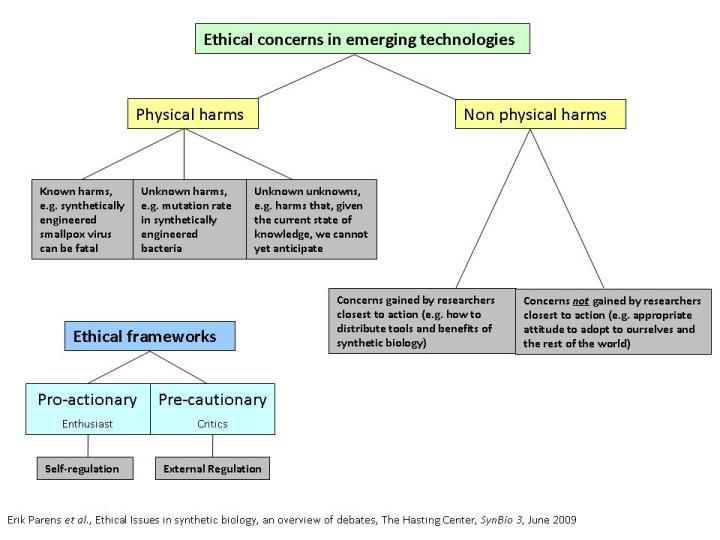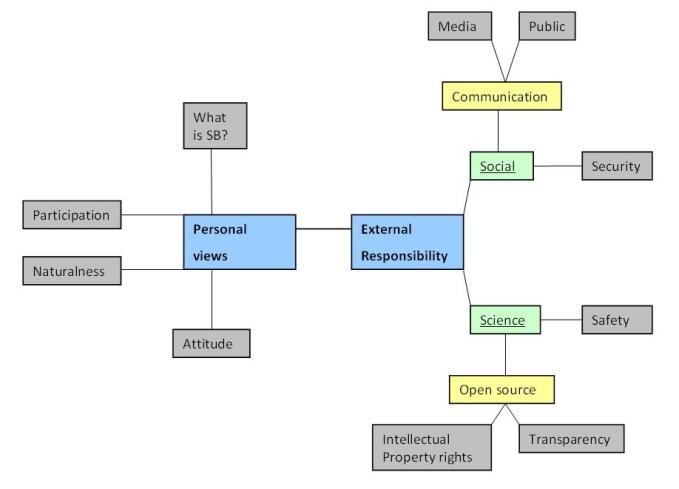Team:TUDelft/Ethics background
From 2009.igem.org
(→Ethical issues in synthetic biology) |
|||
| Line 2: | Line 2: | ||
=Ethical issues in synthetic biology= | =Ethical issues in synthetic biology= | ||
| - | + | <br> | |
==Introduction== | ==Introduction== | ||
Revision as of 15:25, 8 September 2009
Ethical issues in synthetic biology
Introduction
The marriage between technologies in molecular and cellular biology together with genetic and chemical engineering gave life to a new phenomenon called synthetic biology. Since then, a lot of ethical questions were raised. Although the definition of synthetic biology is not yet clear and future implications are yet uncertain, research in the field of synthetic biology is at its peak. Different articles claim that synthetic biology is the answer to curing cancer and the production of bio-fuel, and several leading universities assembled specific departments for this field of research. An OpenWetware created by the Massachusetts Institute for Technology, gives free access to a large registry of BioBricks: basic “ready to use” biological machinery components. The most important resource for these BioBricks comes from the yearly iGEM (international genetically engineered machine) competition, in which teams of students can compete on building the best microorganism machine by combining, describing, implementing and/or designing these biological standardized parts.
Definition
Although the term has been abundantly used for almost a decade, there is no consensus on a definition for synthetic biology. Different practical approaches to synthetic biology research and engineering emanate from different disciplines, resulting in an intangible characterization. An attempt by the European Commission to describe synthetic biology resulted in partial acknowledgement by the scientific community. The EC tried to reflect how synthetic biology differs from other emerging technologies and focused on constructing of artificial life forms with use of engineering principles applicable in biology. Their working definition of synthetic biology is as follows:
“Synthetic Biology is the engineering of biological components and systems that do not exist in nature and the re-engineering of existing biological elements; it is determined on the intentional design of artificial biological systems, rather than on the understanding of natural biology” (EC, 2005).
Frameworks
There is a lot of literature on ethical issues in synthetic biology. A road map to illustrate these main concerns is shown in Figure 1. This road map (based on a paper of [http://www.synbioproject.org/library/publications/archive/synbio3/.com Parens, 2009]) is generally applicable for emerging technologies, but is currently designed to focus on synthetic biology. The ethical concerns that are mainly addressed in literature are "physical harms" and concerns gained by researchers "closest to action" in synthetic biology. The first concerns on bio-safety and bio-security, where the latter involves matters such as intellectual property rights and transparency.
Unfortunately the scientific community lacks an appropriate attitude towards themselves and the rest of the world. An under valuated but nevertheless important subject in synthetic biology is the fact that we might change the perception of life when we try to (re)engineer life or even try to create it from scratch (Craig Venter's [http://www.pnas.org/content/103/2/425.abstract minimal genome project]). The reductionist approach (a method of understanding complex systems by analyzing the subsystems that it is composed of) has brought a lot of benefits in understanding physics and chemistry, and has definitely helped in understanding biological systems. But now we have come to the point that we are designing living systems. Some even believe we are at the brink of defining and even creating life. The concerns and consequences of this progression should be described and discussed elaborately.
Parens et al. also describes a framework that distinguishes two groups responding differently to questions concerning physical harms. The pro-actionary people think more of the benefits of the research than its possible implications. The pre-cautionary community is concerned about safety and security instead of rather thinking about the opportunities. As it comes to regulation and policies, the enthusiasts would keep the authority to themselves, whereas the critics would rather see external regulation on safety and security issues.
Concerns
The concerns in synthetic biology that typically appear in literature include bio-safety, bio-security, transparency and intellectual property rights. Topics concerning the attitude towards life, reductionism and public involvement that are relatively hard to address but nonetheless important, do not obtain the attention they deserve. A list of the ethical concerns:
- Bio-safety (Regulations for working in synthetic biology)
- Bio-security (Consequences of synthetic biology, e.g. bio-terrorism)
- Intellectual property rights (conflict of interest, fair distribution of benefits and who owns what?)
- Transparency (open source, availability)
- Communication (towards public and media)
- Naturalness (or artificialness)
- Attitude (towards life)
- Reductionism (consequences and implications when reducing biological systems)
Since the introduction of synthetic biology, ethical issues have been addressed and different opinions, frameworks and solutions have been proposed. To get an overview of opinions and responsibilities relevant to different topics, we propose a framework that describes the main ethical considerations from a personal perspective, as shown in Figure 2.
The personal view describes features on how we perceive synthetic biology, what is our attitude towards life, and why do we participate in such research. The believes, perceptions and reasons for people to understand and work in the field of biology will vary between individuals. It is good to give these different subjects some thought, to make evaluation of the research somewhat easier. Moreover, when working together in a team it is important to know that team members can have different opinions. A healthy discussion can help the research because you can respect each others differences, learn of other viewpoints. Furthermore, it shows peoples personal qualities.
Externally, researchers are responsible on a social level for communication and security of the public. On a scientific level they should concern the safety of themselves and co-workers. In synthetic biology specifically they have to think about the consequences of making biological components freely available, how to deal with intellectual property rights and to what extend the research should be transparent to the community.
Responsibility
The proposed framework can function as a guideline for what is important and what are our responsibilities when working on synthetic biology. Although most of the topics are addressed in literature, policymakers are lagging behind in making regulations concerning these topics. Specifically a lot of questions are raised concerning bio-safety and bio-security. For example, what are the possibilities for bio terrorist or what are the consequences of do-it-yourself synthetic biology, where people can engineer organisms in their own backyard. Regulations and policies should clear up this uncertainty. But the problem is: who is responsible? Should the government create certain guidelines, or should the scientific community self-regulate their own research? Are existing guidelines and safety measures on genetic engineering enough, or do we need to extend this? What about the open source properties, what if somebody patents a gene? Another question that follows from this discussion is whether synthetic biology is as new as some papers make us believe. Do we really need new guidelines? Did we not already describe safety regulations to keep modified organisms in the laboratories?
These are difficult questions, certainly because key stakeholders will have different opinions and demands. Although these questions have an ethical undertone, they are better categorized in the policy and regulatory field. The ethical aspects have been described extensively. It is now up to the policymakers to identify the problems, see where guidelines are needed and implement clear regulations when necessary.
 "
"









